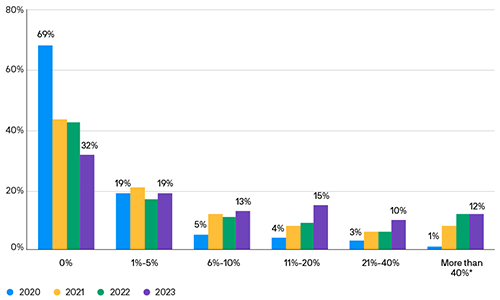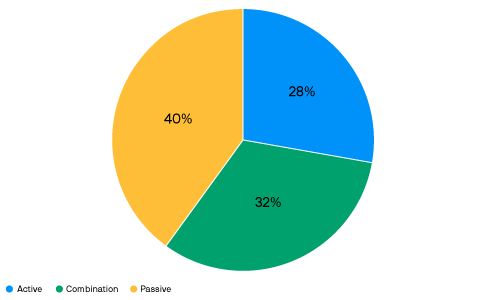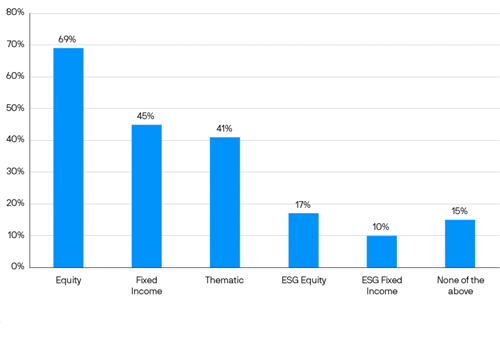European investors plan to increase their allocation to active ETFs – a market where tremendous innovation occurred. ESG will continue to be one of the major drivers in ETF allocations.
The momentum in ETF flows has continued to be eye-catching. By the end of 2022, the global ETF space had reached 11 trillion dollar in assets under management (AuM).
If it continues to grow at the current pace, assets are set to double by 2027, with several major drivers behind this including continued client adoption, accelerating demand for active ETFs and a bigger focus on fixed income.
The 2023 Trackinsight Global ETF survey shows that the share of ETF buyers who do not allocate to active ETFs has decreased year-on-year from over 45 percent in 2021 to just over 30 percent in 2023.
How Much of Your Portfolio is Invested in Active ETFs?

Source: Trackinsight Global ETF survey 2020 - 2023. (Click on the graphic to enlarge)
We have also seen a recent acceleration of active ETF flows. In the US, 33 percent of flows went into active ETFs in Q1 of 2023 and in the UCITS space it was 6 percent (source: Bloomberg as of 31 March 2023). This momentum is only likely to continue, according to several other recently published surveys.
According to the Brown Brothers Herriman (BBH) 2023 Global ETF Investor Survey, 32 percent of European investors plan to increase their allocation to active ETFs this year. This is also echoed by the PwC survey «ETFs 2027: A world of new possibilities» which states that 30 percent of ETF buyers in Europe expect significant demand for active ETFs in the next two to three years.
Evolution of the Active ETF Market
Tremendous innovation has occurred in the active ETF market in recent years. There are now 18 ETF issuers who offer active UCITS ETFs with over 70 ETFs available to invest in (source: ETFbook as of 31 March 2023). Fixed income remains the biggest asset class for active ETF allocations, with 47 percent of active UCITS ETF assets aligned to fixed income strategies.
The active ETF market is already as diverse as the active mutual fund market, ranging from index-like active research enhanced indexing strategies, to higher tracking error, unconstrained or even thematic strategies. With more active ETF providers entering the market, potential ETF buyers’ concerns regarding a limited product range should decrease over time.
In terms of trading volume, ETFs currently account for 15 percent of European equity activity with an annual turnover of 3 trillion euro. Today, client dealing desks have several options to execute their ETF flow. Understanding the considerations in the trading lifecycle of an ETF can help clients deliver better outcomes.
European ETF secondary market liquidity is not limited to shares trading on a particular stock exchange listing. ETF liquidity providers can trade across multiple venues (both on- and off-exchange) as well as create new shares in the primary market to balance ETF supply and demand.
There is also growing industry recognition about the benefits of a consolidated pricing alongside further technological advances in ETF fair value algorithms. Taken together, these two developments should facilitate higher market trading volumes and improved execution outcomes for clients.
This holds true whether an ETF is active or passive.
ESG Investing And Active ETFs
In 2022, 60 percent of net flows into UCITS ETFs went into environmental, social and governance (ESG) strategies. ESG investing will continue to be one of the major drivers in ETF allocations according to Trackinsight. Its 2023 survey highlighted 30 percent of ETF buyers plan to further increase ESG ETF allocations over the next two to three years.
Interestingly, in the ESG ETF space, active strategies seem to be more popular versus the broader ETF market. Trackinsight’s 2023 survey also revealed nearly 70 percent ETF buyers said they use active ETFs to access ESG strategies, either purely active or in combination with passive.
Only 32 percent solely use passive ETFs for ESG investing.
What is Your Preferred Investment Approach For Investing in ESG ETFs?

Source: Trackinsight 2023 Global ETF survey.
The increased focus on active engagement is a key priority for many investors, with 60 percent of ETF buyers seeing this as an important or very important factor for ESG investing (source: Trackinsight). Working with an active ETF issuer with an investment stewardship team that can join forces with equity and fixed income analysts and portfolio managers can enhance engagement outcomes.
Bonds are Back
40 percent of ETF buyers plan to increase their fixed-income allocation by up to 20 percent or more (source: Trackinsight) and 45 percent see value in utilizing active ETFs for fixed-income investing. Active fixed income ETFs have the ability to assess the creditworthiness of individual issuers and deviate from the weighting methodology of traditional fixed-income benchmarks, which give larger allocation weights to issuers with higher outstanding debts.
Interestingly, only 10 percent see the benefits of ESG fixed income investing in the ETF wrapper (source: Trackinsight), despite the potential for active research to help select issuers with stronger E, S and G credentials. We think as investors get more used to allocating active fixed-income ETFs, the ESG space will be one area of growth.
Do You See Value in Utilizing Active ETFs?

Source: Trackinsight 2023 Global ETF survey. (Click on the graphic to enlarge)
Advancing the Potential of ETFs
J.P. Morgan Asset Management is currently the number one provider for active ETFs in the UCITS space by AuM and one of the largest globally (source: Bloomberg as of 30 April 2023). We have also been named «Best Active ETF Provider» in the ETF Express European Awards in 2022 and 2023 (Past performance is not a reliable guide for current and future performance).
Within the ESG ETF space, our solutions draw on the active insight and in-house data of our global research teams and our investment stewardship experts. We offer over 15 ESG ETFs classified as Article 8 or 9 under the SFDR regulation with over 8 billion dollar in assets under management (source: J.P. Morgan Asset Management as of 30 April 2023).
From core strategies to targeted thematic solutions, investors can choose from a wide range of J.P. Morgan Asset Management ESG ETFs to express sustainability preferences in their portfolios.
- Learn more about active ETFs here.
This is a marketing communication. The views contained herein are not to be taken as advice or a recommendation to buy or sell any investment or interest thereto. Reliance upon information in this material is at the sole discretion of the reader. Any research in this document has been obtained and may have been acted upon by J.P. Morgan Asset Management for its own purpose. The results of such research are being made available as additional information and do not necessarily reflect the views of J.P. Morgan Asset Management. Any forecasts, figures, opinions, statements of financial market trends or investment techniques and strategies expressed are, unless otherwise stated, J.P. Morgan Asset Management’s own at the date of this document. They are considered to be reliable at the time of writing, may not necessarily be all inclusive and are not guaranteed as to accuracy. They may be subject to change without reference or notification to you. The value of investments and the income from them may fluctuate in accordance with market conditions and investors may not get back the full amount invested. Past performance and yield are not a reliable indicator of current and future results. There is no guarantee that any forecast made will come to pass. J.P. Morgan Asset Management is the brand name for the asset management business of JPMorgan Chase & Co. and its affiliates worldwide. To the extent permitted by applicable law, we may record telephone calls and monitor electronic communications to comply with our legal and regulatory obligations and internal policies. Personal data will be collected, stored and processed by J.P. Morgan Asset Management in accordance with our EMEA Privacy Policy www.jpmorgan.com/emea-privacy-policy. This communication is issued in Europe (excluding UK) by JPMorgan Asset Management (Europe) S.à r.l., 6 route de Trèves, L-2633 Senningerberg, Grand Duchy of Luxembourg, R.C.S. Luxembourg B27900, corporate capital EUR 10.000.000. Image source: Getty Images. 093d232706130145









